Abstract
The cardiovascular effects of an acute haemorrhage (2% of the body weight) were studied over a 60 min period in three groups of rats: (a) Brattleboro rats with hereditary hypothalamic diabetes insipidus (b.d.i.) lacking circulating vasopressin, (b) control rats of the parent Long Evans (l.e.) strain, and (c) l.e. rats treated with an antagonist of the vascular action of vasopressin. Prior to the haemorrhage there were no significant differences between the three groups of rats with respect to mean arterial blood pressure, cardiac output, stroke volume or total peripheral resistance. Following the haemorrhage cardiac output and stroke volume were severely reduced in all three groups of rats. Total peripheral resistance was relatively unaffected in antagonist-treated l.e. rats and b.d.i. rats, but rose substantially in response to the loss of blood in the control l.e. group. Both total peripheral resistance and mean arterial blood pressure were markedly greater in the untreated l.e. control rats than in the other two groups of animals during the first 20 min after haemorrhage. The mean heart rate measured in Brattleboro rats was elevated compared with that of control l.e. rats throughout the experiment and, in addition, significantly greater than that of antagonist-treated l.e. rats during the first 40 min after the haemorrhage. Survival rate for the b.d.i. rats following the 2% haemorrhage was lower than that for l.e. control rats and antagonist-treated l.e. rats. The results indicate that the recovery of the blood pressure following an acute arterial haemorrhage is significantly influenced by vasopressin, particularly during the first 20 min, and that the predominant effect of the hormone is to increase the total peripheral resistance. The higher mortality associated with volume depletion in the b.d.i. rats is unlikely to be directly related to the absence of the vascular action of vasopressin, since administration of the vasopressin antagonist to normal l.e. rats does not reduce their survival rate.
Full text
PDF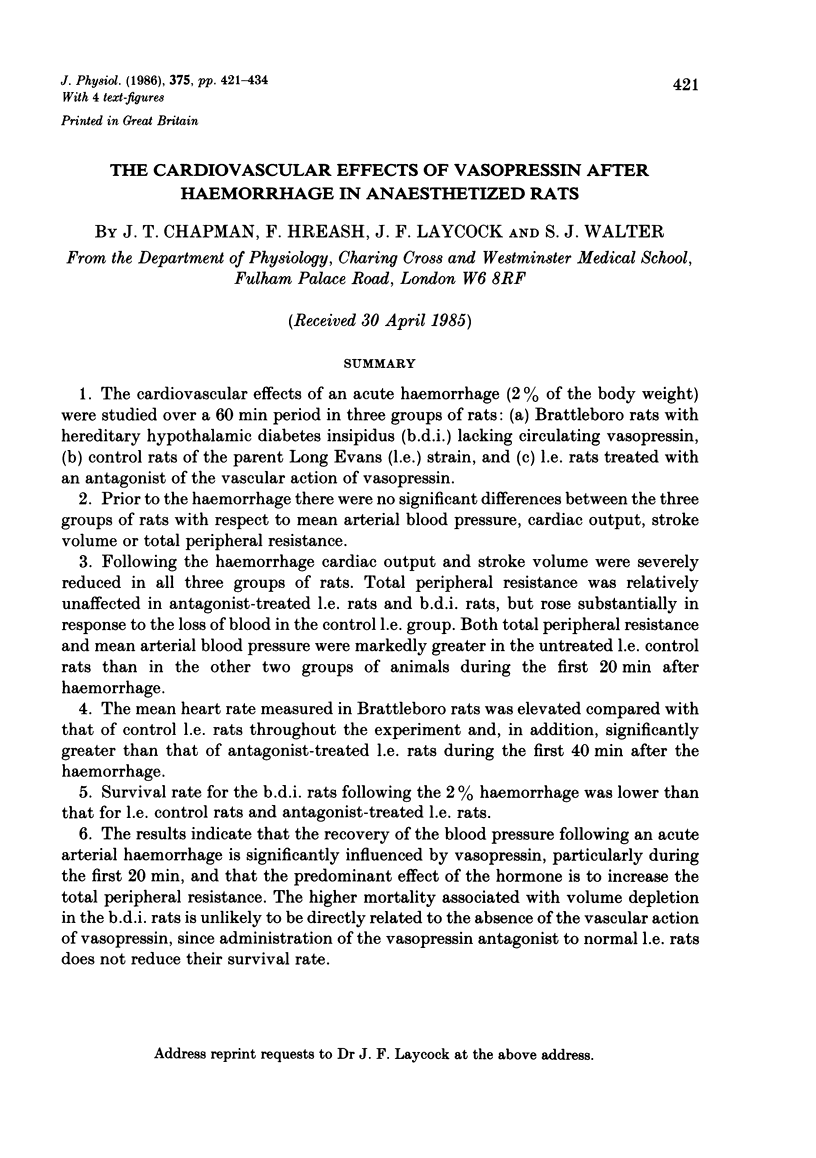
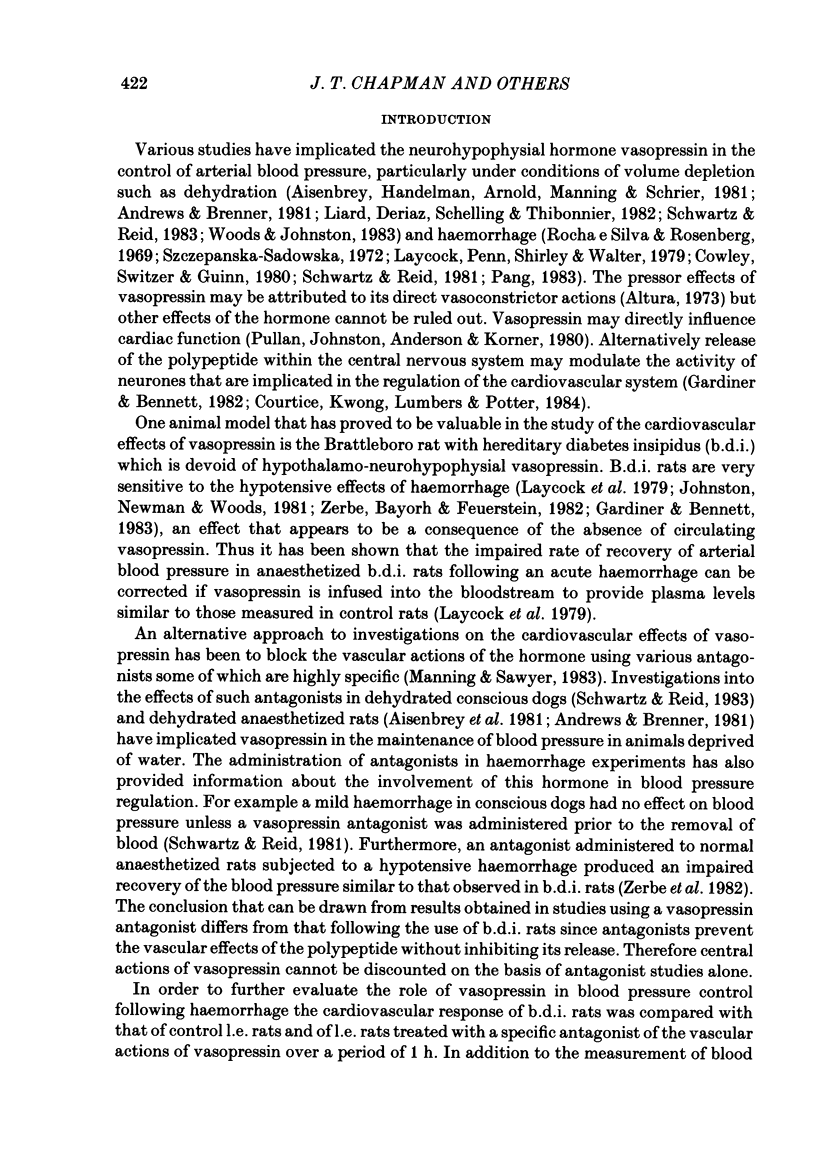








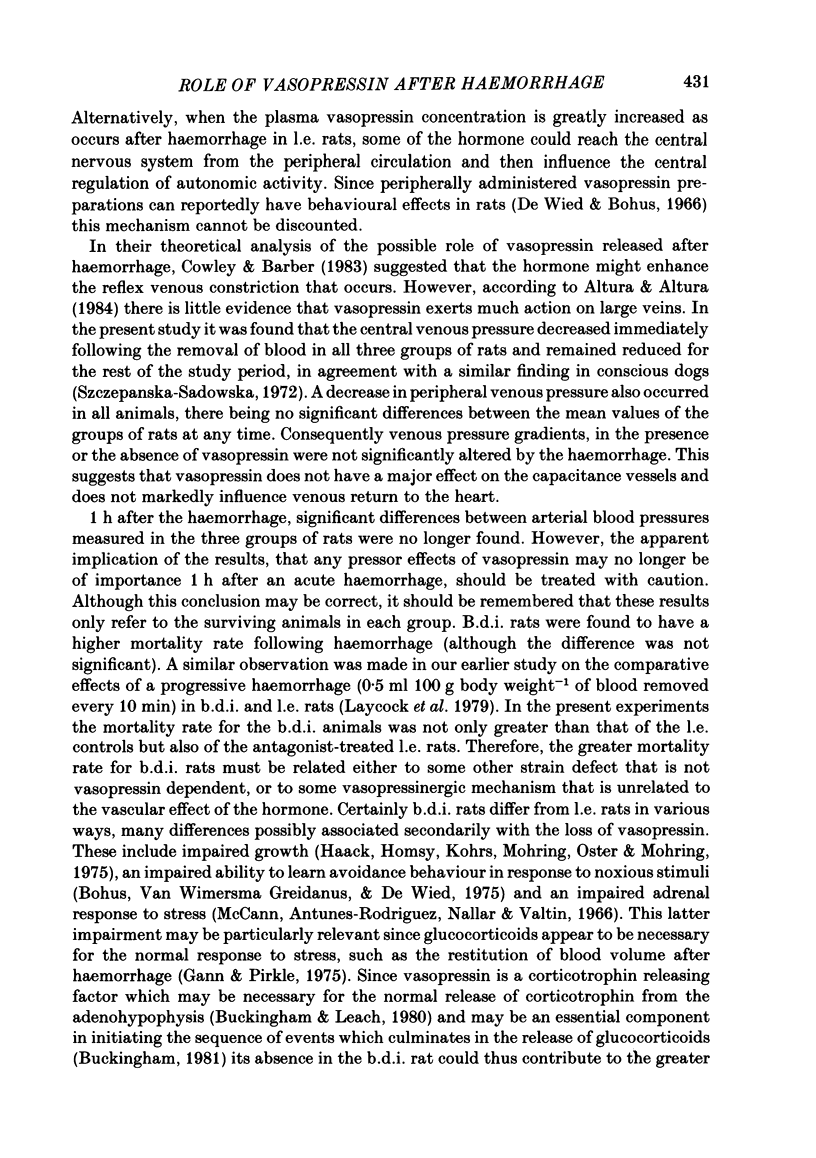
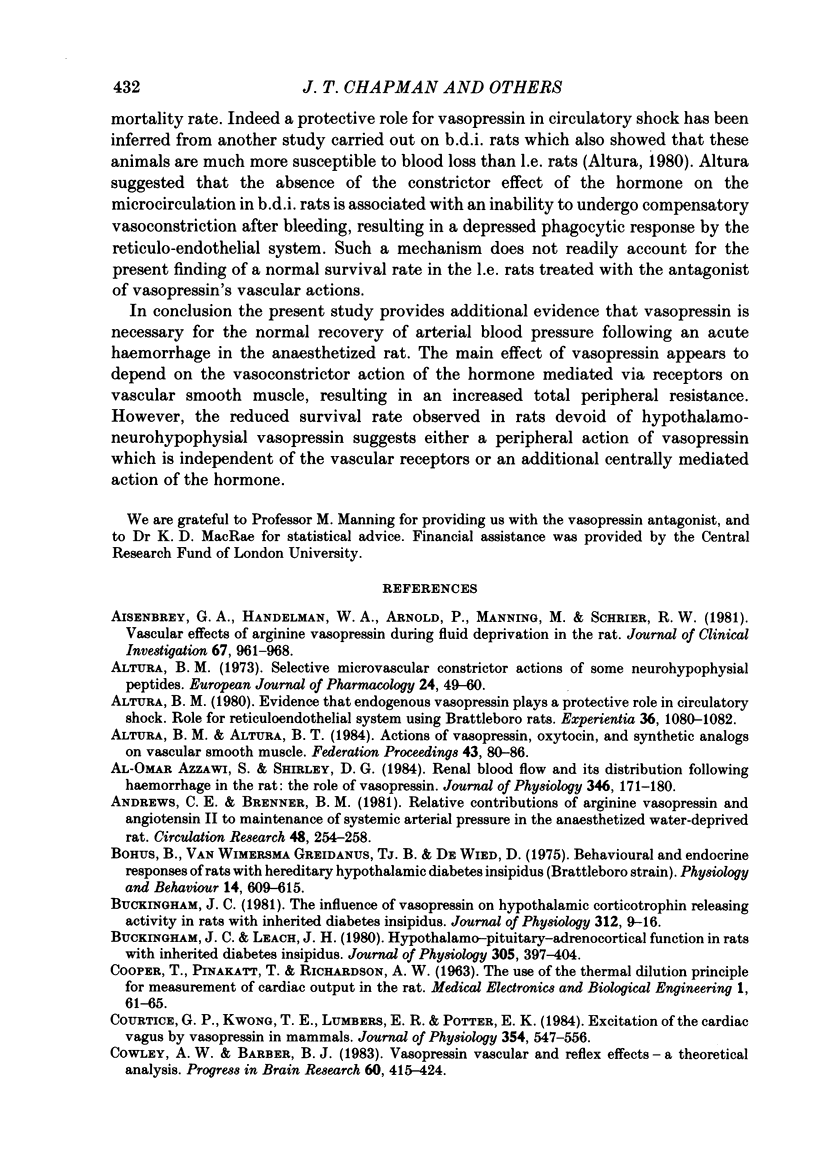
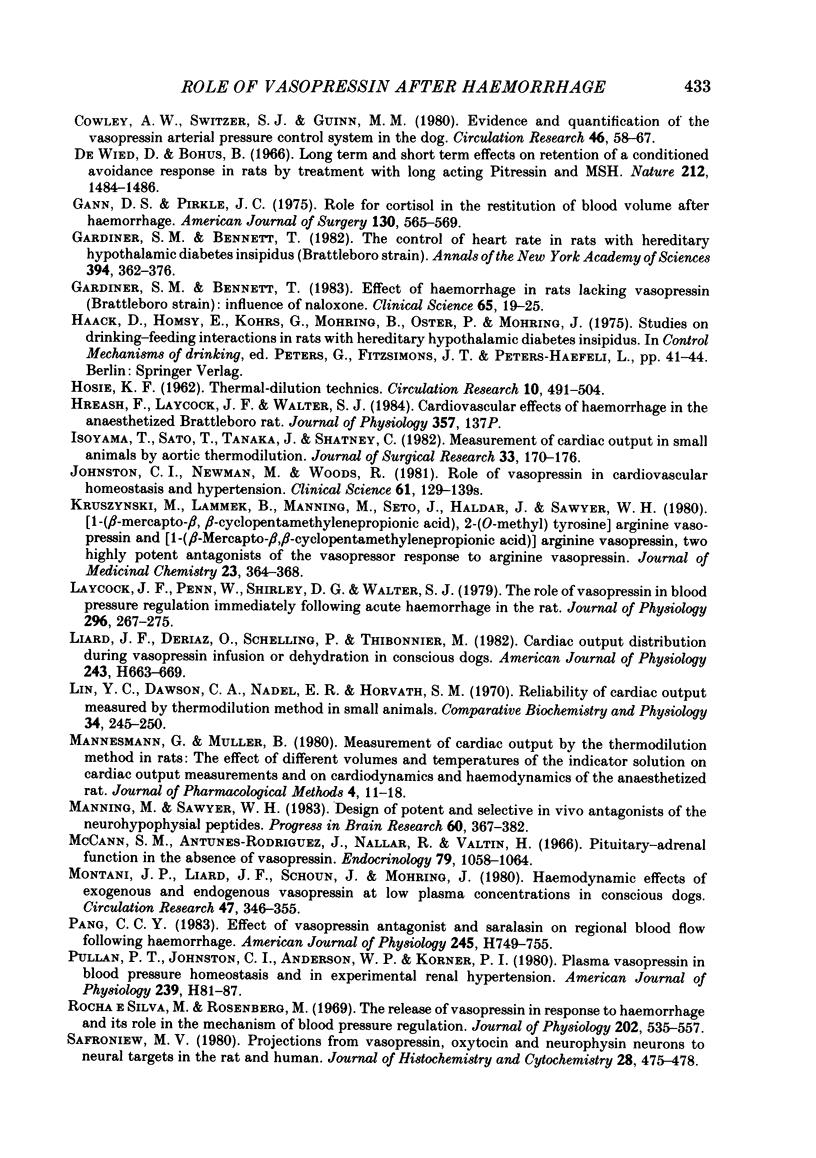

Selected References
These references are in PubMed. This may not be the complete list of references from this article.
- Aisenbrey G. A., Handelman W. A., Arnold P., Manning M., Schrier R. W. Vascular effects of arginine vasopressin during fluid deprivation in the rat. J Clin Invest. 1981 Apr;67(4):961–968. doi: 10.1172/JCI110146. [DOI] [PMC free article] [PubMed] [Google Scholar]
- Al-Omar Azzawi S., Shirley D. G. Renal blood flow and its distribution following haemorrhage in the rat: the role of vasopressin. J Physiol. 1984 Jan;346:171–179. doi: 10.1113/jphysiol.1984.sp015014. [DOI] [PMC free article] [PubMed] [Google Scholar]
- Altura B. M., Altura B. T. Actions of vasopressin, oxytocin, and synthetic analogs on vascular smooth muscle. Fed Proc. 1984 Jan;43(1):80–86. [PubMed] [Google Scholar]
- Altura B. M. Evidence that endogenous vasopressin plays a protective role in circulatory shock. Role for reticuloendothelial system using Brattleboro rats. Experientia. 1980 Sep 15;36(9):1080–1082. doi: 10.1007/BF01965981. [DOI] [PubMed] [Google Scholar]
- Altura B. M. Selective microvascular constrictor actions of some neurohypophyseal peptides. Eur J Pharmacol. 1973 Oct;24(1):49–60. doi: 10.1016/0014-2999(73)90113-1. [DOI] [PubMed] [Google Scholar]
- Andrews C. E., Jr, Brenner B. M. Relative contributions of arginine vasopressin and angiotensin II to maintenance of systemic arterial pressure in the anesthetized water-deprived rat. Circ Res. 1981 Feb;48(2):254–258. doi: 10.1161/01.res.48.2.254. [DOI] [PubMed] [Google Scholar]
- Bohus B., Greidanus T. V., DE Wied D. Behavioral and endocrine responses of rats with hereditary hypothalamic diabetes insipidus (Brattleboro strain). Physiol Behav. 1975 May;14(5):609–615. doi: 10.1016/0031-9384(75)90189-4. [DOI] [PubMed] [Google Scholar]
- Buckingham J. C., Leach J. H. Hypothalamo-pituitary-adrenocortical function in rats with inherited diabetes insipidus. J Physiol. 1980 Aug;305:397–404. doi: 10.1113/jphysiol.1980.sp013371. [DOI] [PMC free article] [PubMed] [Google Scholar]
- Buckingham J. C. The influence of vasopressin on hypothalamic corticotrophin releasing activity in rats with inherited diabetes insipidus. J Physiol. 1981 Mar;312:9–16. doi: 10.1113/jphysiol.1981.sp013612. [DOI] [PMC free article] [PubMed] [Google Scholar]
- Courtice G. P., Kwong T. E., Lumbers E. R., Potter E. K. Excitation of the cardiac vagus by vasopressin in mammals. J Physiol. 1984 Sep;354:547–556. doi: 10.1113/jphysiol.1984.sp015392. [DOI] [PMC free article] [PubMed] [Google Scholar]
- Cowley A. W., Jr, Barber B. J. Vasopressin vascular and reflex effects--a theoretical analysis. Prog Brain Res. 1983;60:415–424. doi: 10.1016/S0079-6123(08)64408-8. [DOI] [PubMed] [Google Scholar]
- Cowley A. W., Jr, Switzer S. J., Guinn M. M. Evidence and quantification of the vasopressin arterial pressure control system in the dog. Circ Res. 1980 Jan;46(1):58–67. doi: 10.1161/01.res.46.1.58. [DOI] [PubMed] [Google Scholar]
- Gann D. S., Pirkle J. C., Jr Role of cortisol in the restitution of blood volume after hemorrhage. Am J Surg. 1975 Nov;130(5):565–569. doi: 10.1016/0002-9610(75)90513-9. [DOI] [PubMed] [Google Scholar]
- Gardiner S. M., Bennett T. Effects of haemorrhage in rats lacking vasopressin (Brattleboro strain): influence of naloxone. Clin Sci (Lond) 1983 Jul;65(1):19–25. doi: 10.1042/cs0650019. [DOI] [PubMed] [Google Scholar]
- HOSIE K. F. Thermal-dilution technics. Circ Res. 1962 Mar;10:491–504. doi: 10.1161/01.res.10.3.491. [DOI] [PubMed] [Google Scholar]
- Isoyama T., Sato T., Tanaka J., Shatney C. H. Measurement of cardiac output in small animals by aortic thermodilution. J Surg Res. 1982 Aug;33(2):170–176. doi: 10.1016/0022-4804(82)90025-7. [DOI] [PubMed] [Google Scholar]
- Johnston C. I., Newman M., Woods R. Role of vasopressin in cardiovascular homeostasis and hypertension. Clin Sci (Lond) 1981 Dec;61 (Suppl 7):129s–139s. doi: 10.1042/cs061129s. [DOI] [PubMed] [Google Scholar]
- Kruszynski M., Lammek B., Manning M., Seto J., Haldar J., Sawyer W. H. [1-beta-Mercapto-beta,beta-cyclopentamethylenepropionic acid),2-(O-methyl)tyrosine ]argine-vasopressin and [1-beta-mercapto-beta,beta-cyclopentamethylenepropionic acid)]argine-vasopressine, two highly potent antagonists of the vasopressor response to arginine-vasopressin. J Med Chem. 1980 Apr;23(4):364–368. doi: 10.1021/jm00178a003. [DOI] [PubMed] [Google Scholar]
- Laycock J. F., Penn W., Shirley D. G., Walter S. J. The role of vasopressin in blood pressure regulation immediately following acute haemorrhage in the rat. J Physiol. 1979 Nov;296:267–275. doi: 10.1113/jphysiol.1979.sp013004. [DOI] [PMC free article] [PubMed] [Google Scholar]
- Liard J. F., Dériaz O., Schelling P., Thibonnier M. Cardiac output distribution during vasopressin infusion or dehydration in conscious dogs. Am J Physiol. 1982 Nov;243(5):H663–H669. doi: 10.1152/ajpheart.1982.243.5.H663. [DOI] [PubMed] [Google Scholar]
- Lin Y. C., Dawson C. A., Nadel E. R., Horvath S. M. Reliability of cardiac output measured by thermodilution method in small animals. Comp Biochem Physiol. 1970 May 1;34(1):245–250. doi: 10.1016/0010-406x(70)90073-3. [DOI] [PubMed] [Google Scholar]
- Mannesmann G., Müller B. Measurement of cardiac output by the thermodilution method in rats: the effect of different volumes and temperatures of the indicator solution on cardiac output measurements and on cardiodynamics and hemodynamics of the anesthetized rat. J Pharmacol Methods. 1980 Aug;4(1):11–18. doi: 10.1016/0160-5402(80)90039-x. [DOI] [PubMed] [Google Scholar]
- Manning M., Sawyer W. H. Design of potent and selective in vivo antagonists of the neurohypophysial peptides. Prog Brain Res. 1983;60:367–382. doi: 10.1016/S0079-6123(08)64404-0. [DOI] [PubMed] [Google Scholar]
- McCann S. M., Antunes-Rodrigues J., Nallar R., Valtin H. Pituitary-adrenal function in the absence of vasopressin. Endocrinology. 1966 Dec;79(6):1058–1064. doi: 10.1210/endo-79-6-1058. [DOI] [PubMed] [Google Scholar]
- Montani J. P., Liard J. F., Schoun J., Möhring J. Hemodynamic effects of exogenous and endogenous vasopressin at low plasma concentrations in conscious dogs. Circ Res. 1980 Sep;47(3):346–355. doi: 10.1161/01.res.47.3.346. [DOI] [PubMed] [Google Scholar]
- Pang C. C. Effect of vasopressin antagonist and saralasin on regional blood flow following hemorrhage. Am J Physiol. 1983 Nov;245(5 Pt 1):H749–H755. doi: 10.1152/ajpheart.1983.245.5.H749. [DOI] [PubMed] [Google Scholar]
- Pullan P. T., Johnston C. I., Anderson W. P., Korner P. I. Plasma vasopressin in blood pressure homeostasis and in experimental renal hypertension. Am J Physiol. 1980 Jul;239(1):H81–H87. doi: 10.1152/ajpheart.1980.239.1.H81. [DOI] [PubMed] [Google Scholar]
- Rocha E Silva M., Jr, Rosenberg M. The release of vasopressin in response to haemorrhage and its role in the mechanism of blood pressure regulation. J Physiol. 1969 Jun;202(3):535–557. doi: 10.1113/jphysiol.1969.sp008826. [DOI] [PMC free article] [PubMed] [Google Scholar]
- Schwartz J., Reid I. A. Effect of vasopressin blockade on blood pressure regulation during hemorrhage in conscious dogs. Endocrinology. 1981 Nov;109(5):1778–1780. doi: 10.1210/endo-109-5-1778. [DOI] [PubMed] [Google Scholar]
- Sofroniew M. V. Projections from vasopressin, oxytocin, and neurophysin neurons to neural targets in the rat and human. J Histochem Cytochem. 1980 May;28(5):475–478. doi: 10.1177/28.5.7381192. [DOI] [PubMed] [Google Scholar]
- Szczepańska-Sadowska E. The activity of the hypothalamo-hypophysial antidiuretic system in conscious dogs. I. The influence of isoosmotic blood volume changes. Pflugers Arch. 1972;335(2):139–146. doi: 10.1007/BF00592040. [DOI] [PubMed] [Google Scholar]
- Walter S. J., Laycock J. F., Shirley D. G. A micropuncture study of proximal tubular function after acute hydrochlorothiazide administration to Brattleboro rats with diabetes insipidus. Clin Sci (Lond) 1979 Nov;57(5):427–434. doi: 10.1042/cs0570427. [DOI] [PubMed] [Google Scholar]
- Woods R. L., Johnston C. I. Contribution of vasopressin to the maintenance of blood pressure during dehydration. Am J Physiol. 1983 Nov;245(5 Pt 1):F615–F621. doi: 10.1152/ajprenal.1983.245.5.F615. [DOI] [PubMed] [Google Scholar]
- Yamashita H., Kannan H., Inenaga K., Koizumi K. Role of neurones in the supraoptic and paraventricular nuclei in cardiovascular control. Prog Brain Res. 1983;60:459–468. doi: 10.1016/S0079-6123(08)64412-X. [DOI] [PubMed] [Google Scholar]
- Zerbe R. L., Bayorh M. A., Feuerstein G. Vasopressin: an essential pressor factor for blood pressure recovery following hemorrhage. Peptides. 1982 May-Jun;3(3):509–514. doi: 10.1016/0196-9781(82)90117-6. [DOI] [PubMed] [Google Scholar]
- Zerbe R. L., Feuerstein G., Meyer D. K., Kopin I. J. Cardiovascular, sympathetic, and renin-angiotensin system responses to hemorrhage in vasopressin-deficient rats. Endocrinology. 1982 Aug;111(2):608–613. doi: 10.1210/endo-111-2-608. [DOI] [PubMed] [Google Scholar]


